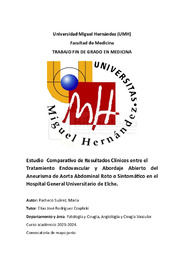Por favor, use este identificador para citar o enlazar este ítem:
https://hdl.handle.net/11000/33866Estudio Comparativo de Resultados Clínicos entre el Tratamiento Endovascular y Abordaje Abierto del Aneurisma de Aorta Abdominal Roto o Sintomático en el Hospital General Universitario de Elche.
| Título : Estudio Comparativo de Resultados Clínicos entre el Tratamiento Endovascular y Abordaje Abierto del Aneurisma de Aorta Abdominal Roto o Sintomático en el Hospital General Universitario de Elche. |
| Autor : Pacheco Suárez, María |
| Tutor: Rodríguez Czaplicki, Elías José |
| Editor : Universidad Miguel Hernández |
| Departamento: Departamentos de la UMH::Patología y Cirugía |
| Fecha de publicación: 2024-04-29 |
| URI : https://hdl.handle.net/11000/33866 |
| Resumen : Introducción: La rotura de un aneurisma de aorta abdominal presenta una mortalidad enormemente relevante de hasta un 90%, y supone una emergencia quirúrgica que requiere reparación inmediata, pudiendo ser por medio de cirugía abierta o por un abordaje endovascular. Este último ha presentado un crecimiento exponencial en comparación con la cirugía abierta dado que ha demostrado numerosas ventajas en términos de morbimortalidad, complicaciones y duración de ingreso hospitalario. Objetivo: Comparar la diferencia referente a los resultados clínicos acerca de la mortalidad, circunstancias al alta, tiempo de ingreso hospitalario y complicaciones en función de la técnica quirúrgica empleada para la reparación de la rotura de aneurisma de aorta abdominal. Métodos: Se realiza un estudio observacional de tipo serie de casos mediante la revisión retrospectiva de historias clínicas electrónicas de pacientes intervenidos de AAA roto o sintomático en el Hospital General Universitario de Elche en un periodo de cuatro años. Resultados: Se incluyen un total de 15 pacientes, la totalidad varones y con una media de edad de 77 años, presentando el 100% de ellos tabaquismo activo (66’7%) o antecedentes de hábito tabáquico (33’3%), así como la comorbilidad asociada por otros factores de riesgo cardiovascular como hipertensión arterial (73’3%), diabetes (26’7%) y dislipemia (53’3%). Con respecto a la variable de mortalidad, se obtiene un p-valor significativo de 0’041, siendo un 85’7% de casos los pacientes con éxitus tras la cirugía abierta en comparación con al 14’3% tras el abordaje endovascular. Además, también encontramos un p-valor estadísticamente significativo de 0’077 en relación a las complicaciones. Respecto a la aparición de complicaciones renales y respiratorias y al tiempo de ingreso hospitalario, estos son mayores en aquellos pacientes tratados con EVAR que los intervenidos por medio de cirugía abierta, dado que el 75% de enfermos tratados por OSR fallecieron durante la intervención o en el postoperatorio inmediato por complicaciones, más concretamente parada cardiorrespiratoria y el shock hipovolémico, reflejando un tiempo de ingreso menor, lo que traduce una imposibilidad temporal para el desarrollo de otras complicaciones. Conclusión: Los resultados en relación a la mortalidad muestran que esta es mayor en cirugías abiertas que en endovasculares, obteniendo resultados similares respecto a la aparición de complicaciones. Sin embargo, no todos los pacientes son candidatos a la reparación endovascular, por lo que, a pesar de haber mostrado mejores resultados, no es una opción que pueda generalizarse a toda la población. Introduction: The rupture of an abdominal aortic aneurysm presents an extremely relevant mortality, up to 90%, and represents a surgical emergency which requires immediate repair, which can be performed through open surgery or an endovascular approach. The latter has shown an exponential growth in comparison to open surgery, since it has demonstrated numerous advantages in terms of mortality and morbidity, complications and hospital stay time. Purpose: To compare the difference between clinical results regarding mortality, circumstances at discharge, hospital stay time and complications regarding the surgical technique used to repair the ruptured abdominal aortic aneurysm. Methodology: An observational case series study is carried out through the retrospective review of electronic medical records of patients who underwent surgery to repair a ruptured or symptomatic AAA at the Hospital General Universitario de Elche over a period of four years. Results: A total of 15 patients are included, all being men and with a mean age of 77 years, with 100% of them having active smoking habit (66’7%) or personal history of smoking (33’3%), as well as other comorbidities associated with cardiovascular risk factors such as high blood pressure (73’3%), diabetes (26’7%) and dyslipidaemia (53’3%). Regarding the mortality variable, a significant p-value of 0’041 is obtained, showing that 85’7% of patients died after being treated by open surgery compared to 14’3% treated by an endovascular approach. In addition, we also found a statistically significant p-value of 0’077 in related to the appearance of complications. With regard to the appearance of renal and respiratory complications and the time of hospital stay, these were greater in those patients treated with EVAR than those operated on through open surgery, give that 75% of patients treated with OSR died during or right after the procedure due to complications, more specifically cardiorespiratory arrest and hypovolemic shock, reflecting a shorter hospital stay, which translates to the impossibility, time-wise, for the development of other complications. Conclusion: The results regarding mortality show that it is higher in patients who underwent open surgery than in endovascular procedures, obtaining similar results regarding the appearance of complications. However, not all patients are suitable for endovascular repair, so, despite having shown better results overall, this is not an option that can be generalized to the entire population. |
| Palabras clave/Materias: aneurisma de aorta abdominal cirugía abierta reparación endovascular complicaciones factores de riesgo mortalidad |
| Área de conocimiento : CDU: Ciencias aplicadas: Medicina |
| Tipo de documento : info:eu-repo/semantics/bachelorThesis |
| Derechos de acceso: info:eu-repo/semantics/openAccess Attribution-NonCommercial-NoDerivatives 4.0 Internacional |
| Aparece en las colecciones: TFG- Medicina |
 La licencia se describe como: Atribución-NonComercial-NoDerivada 4.0 Internacional.
La licencia se describe como: Atribución-NonComercial-NoDerivada 4.0 Internacional.
.png)
